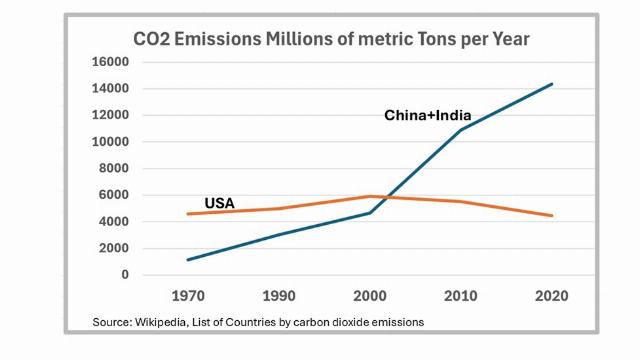

Photo Credit: Image: kie-ker via Pixabay, Pixabay License.
kie-ker
Most people think solar electricity is an excellent choice for powering the electric grid. Most people are delusional.Most people think that solar electricity is an excellent choice for powering the electric grid. Most people are delusional due to overwhelming propaganda.
Solar can work for houses too isolated to be connected to a power line. But as a large-scale power plant, generating 500 or 1,000 megawatts of electricity, solar energy is close to being a hoax.
Solar energy, dependent on the weather and the solar cycle, is unreliable. It must be backed up by conventional generating plants. Solar energy is peaky, peaking around noon. But electricity consumption tends to peak in the early evening.
Solar congestion happens when the flood of electricity at the noon peak overwhelms the grid. Serious solar farms must be equipped with time-shifting batteries that store the excess midday electricity and release it a few hours later when it is needed.
Unsubsidized solar electricity is exorbitantly expensive, costing about $150 per megawatt-hour. When a megawatt-hour of solar electricity is accepted by the electric grid, typically a natural gas generating plant is throttled back to make room for the solar electricity. When the natural gas plant generates one megawatt-hour less, the savings in fuel is about $20. Solar electricity that costs $150 replaces natural gas that costs $20. Not a good business.
The biggest uncertainty when calculating the cost of solar electricity is the investment rate of return needed. A fairly risky investment needs a 12-percent rate of return. A solid and predictable investment can do with an 8-percent rate of return.
For mainstream utility-scale electricity generation, solar without government intervention is not a viable business. But for an isolated community lacking a grid connection, it could be. For example, imagine a mine, or a tourist resort, in an isolated location that uses expensive diesel fuel to generate electricity. The cost of fuel could be $200 to $300 per megawatt-hour. Diesel fuel is far more expensive than natural gas per unit of energy. Diesel generators are less efficient than utility-scale power plants. Solar at $150 per megawatt hour would be competitive.
Such an investment might still be risky. For example, a mine could close If the price of the metal produced declined on volatile world markets. Based on examples like this, we assume that a 12-percent rate of return is reasonable for solar in circumstances where it is viable. This could be called the free market cost of solar electricity.
In the USA, we have plenty of solar electricity from solar farms that fill thousands of acres and cost billions of dollars. That electricity is approximately 85 percent subsidized.
More than half of the states have renewable portfolio laws. These laws mandate that a growing percentage of the electricity generated, or imported, be from “renewable” sources. Although renewable has various definitions, in reality, it means fashionable electricity that is approved by the dumb but formidable environmental lobby. Solar and wind electricity are fashionable. Nuclear, fossil fuel, and hydro are not.
The mandated use of solar enables the oligopoly of large companies that build and operate utility-scale solar farms to demand and get long-term power purchase agreements, lasting for 20 years or more. These agreements remove market risk and make an 8-percent rate of return perfectly reasonable. As a consequence, the price of solar electricity is reduced by one third, from $150 per megawatt hour to $100. That is a $50 subsidy, paid for by the buyer, that assumes most of the risk by signing a long-term contract.
The price of solar electricity is further reduced by about another 50 percent by a fleet of federal subsidies. That reduces the cost to $50 per megawatt-hour. The remaining gap between $50 and the $20 worth of gas saved is filled by increased electric rates — a subsidy paid for by electricity customers. A spreadsheet showing these computations can be downloaded here.
The main justification for the subsidies and market manipulation is that solar (and wind) don’t emit CO2 and thus don’t contribute to the supposed looming climate crisis. The subsidy of $130 per megawatt-hour is the price paid for reducing CO2.
To reduce CO2 emissions by a metric ton, it is necessary to replace 3.5 megawatts of natural gas electricity with solar electricity. The cost is 3.5 x $130 = $455, a big cost for reducing a ton of CO2 emissions.
If instead of subsidizing solar, we subsidize nuclear, the cost of reducing CO2 emissions would be much less — about $140 per metric ton. But the environmental lobby do not like nuclear, and their dislike of nuclear trumps their fear of climate change. Nuclear, unlike solar, can completely replace fossil fuel plants. It is super-reliable. Further, nuclear would be much cheaper if it weren’t for the persistent attempts of the environmental lobby to ban it.
Reducing emissions of CO2 from the U.S. isn’t really getting at the supposed problem, as the graph below shows. It is a major misallocation of effort.
<img alt captext="Wikipedia” src=”https://conservativenewsbriefing.com/wp-content/uploads/2024/10/solar-delusions.jpg”>
Norman Rogers writes often on energy issues. He is the author of the book Dumb Energy. The numbers in this article are round numbers typical of the desert southwest.
<img alt="
Image: kie-ker via Pixabay, Pixabay License.
” captext=”kie-ker” src=”https://conservativenewsbriefing.com/wp-content/uploads/2024/10/solar-delusions-1.jpg”>
Image: kie-ker via Pixabay, Pixabay License.





